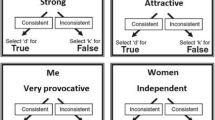Abstract
This study tested the applicability of Tajfel and Turner's (1986) Social Identity Theory (SIT) to cooperative behavior in a mixed-gender setting. SIT suggests that as a “socially subordinate” group in a male-dominated society, women, when their gender is in the numerical minority, will engage in social competition in an attempt to enhance social identity. However, gender-based socialization may encourage men toward competition and women toward cooperation, regardless of group gender composition. In this study, male and female subjects were assigned to a six-person mixed-gender group in which their gender was either in the numerical minority or majority, and performed an interactive task under either cooperative or competitive feedback. An interaction of sex and feedback showed males in the cooperative feedback condition responded more competitively than did males in the competitive feedback condition, while females were equally cooperative in both feedback conditions. Feedback also interacted with the numerical ingroup/outgroup gender balance. While competitive feedback elicited little variation in subjects' responses across the ingroup/outgroup balance variable, the cooperative condition elicited greater competition from subjects in the numerical minority and greater cooperation from those in the numerical majority. Results were interpreted as partial support for SIT, while stressing the need for further investigation into gender as a unique influence on intergroup behavior.
Similar content being viewed by others
References
Becker, W. M., & Miles, C. (1978). Interpersonal competition and cooperation as a function of sex of subject and sex of counterpart. Journal of Social Psychology, 104, 303–304.
Billig, M., & Tajfel, H. (1973). Social categorization and similarity in intergroup behavior. European Journal of Social Psychology, 3, 27–51.
Block, J. H. (1979). Another look at sex differentiation in the socialization behavior of mothers and fathers. In J. Sherman & F. L. Denmark (Eds.), Psychology of women: Future directions of research. New York: Psychological Dimensions.
Bond, J., & Vinacke, W. E. (1961). Coalition in mixed-sex triads. Sociometry, 24, 61–75.
Branthwaite, A., & Jones, J. (1975). Fairness and discrimination: English versus Welsh. European Journal of Social Psychology, 5, 323–328.
Brewer, M. B. (1979). In-group bias in the minimal intergroup situation: A cognitive-motivational analysis. Psychological Bulletin, 86(2), 307–324.
Brewer, M. B., & Silver, M. (1978). Ingroup bias as a function of task characteristics. European Journal of Social Psychology, 8, 393–400.
Espinoza, J. A., & Garza, R. T. (1985). Social group salience and interethnic cooperation. Journal of Experimental Social Psychology, 21, 380–392.
Farley, J. E. (1982). Majority-minority relations. Englewood Cliffs, NJ: Prentice-Hall, Inc.
Garza, R. T., & Herringer, L. G. (1987). Social identity: A multi-dimensional approach. Journal of Social Psychology, 127(3), 299–308.
Garza, R. T., & Santos, S. J. (in press). Ingroup-outgroup balance and interdependent, interethnic behavior. Journal of Experimental Social Psychology.
Gerard, H. B., & Hoyt, M. F. (1974). Distinctiveness of social categorization and attitude toward intergroup members. Journal of Personality and Social Psychology, 27, 836–842.
McClintock, C. G., & Moskowitz, J. M. (1976). Children's preferences for individualistic, cooperative, and competitive outcomes. Journal of Personality and Social Psychology, 34, 543–555.
McGuire, W. J., McGuire, C. V., & Winton, W. (1979). Effects of house-hold sex composition on the salience of one's gender in the spontaneous self concept. Journal of Experimental Social Psychology, 15, 77–90.
Pleck, J. (1980). Men's power with women other men, and society: A men's movement analysis. In E. Pleck & J. Pleck (Eds.), The American man. Englewood Cliffs, NJ: Prentice Hall.
Sherif, M. (1966). In common predicament: Social psychology of intergroup conflict and cooperation. Boston: Houghton Mifflin.
Sherif, M., Harvey, O. J., White, B. J., Hood, W. R., & Sherif, C. W. (1961). Intergroup conflict and cooperation: The Robbers' Cave experiment. Norman, OK: University Book Exchange.
Tajfel, H. (1978). The achievement of group differentiation. In H. Tajfel (Ed.), Differentiation between social groups: Studies in the social psychology of intergroup relations. New York/London: Academic Press.
Tajfel, H., Billing, M., Bundy, R., & Flament, C. (1971). Social categorization and intergroup behavior. European Journal of Social Psychology, 1, 150–177.
Tajfel, H., & Turner, J. C. (1986). The social idnetity theory of intergroup behavior. In S. Worchel & W. G. Austin (Eds.), Psychology of intergroup relations (2nd ed.). Chicago: Nelson-Hall.
Taylor, S. E. (1981). A categorization approach to stereotyping. In D. L. Hamilton (Ed.), Cognitive processes in stereotyping and intergroup behavior. Hillsdale, NJ: Erlbaum.
Turner, J. C. (1975). Social identity and social comparison: Some prospects for intergroup behavior. European Journal of Social Psychology, 5, 5–34.
Turner, J. C. (1982). Towards a cognitive redefinition of the socal group. In H. Tajfel (Ed.), Socialidentity and intergroup relations. Cambridge, MA: Cambridge University Press.
Turner, J. C., Brown, R., & Tajfel, H. (1979). Social comparison and group interest in ingroup favoritism. European Journal of Social Psychology, 9, 187–204.
Williams, J. (1984). Gender and intergroup behavior: Towards an intergration. British Journal of Social Psychology, 23, 311–316.
Williams, J., & Giles, H. (1978). Changing status of women: Intergroup perspectives. In H. Tajfel (Ed.), Differentiation between social groups: Studies in the social psychology of intergroup relations. London: Academic Press.
Author information
Authors and Affiliations
Additional information
This research was supported by an intramural faculty grant from the University of California, Riverside.
Rights and permissions
About this article
Cite this article
Garza, R.T., Borchert, J.E. Maintaining social identity in a mixed-gender setting: Minority/majority status and cooperative/competitive feedback. Sex Roles 22, 679–691 (1990). https://doi.org/10.1007/BF00292054
Issue Date:
DOI: https://doi.org/10.1007/BF00292054




